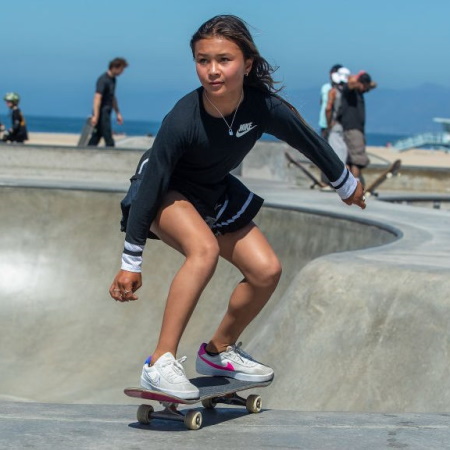How to Protect Your Skateboard While Riding
Riding a skateboard can be a fun and rewarding activity, but it's important to protect yourself and your skateboard while riding. By wearing protective gear, maintaining your skateboard, choosing the right riding environment, and following safety guidelines, you can enjoy skateboarding with confidence and reduce the risk of accidents and injuries.
In this blog post, we'll provide tips and strategies for protecting your skateboard while riding. Whether you're a beginner or an experienced rider, these tips will help you get the most out of your skateboard and your riding experience. So let's get started!
Wear protective gear
Wearing protective gear is an important step in protecting yourself and your skateboard while riding. Protective gear can help reduce the risk of injury and improve your confidence and comfort while riding. Here are some tips for wearing protective gear:
- Wear a helmet: A helmet is the most important piece of protective gear for skateboarding. A helmet can protect your head and brain from serious injury in the event of a fall or collision. When selecting a helmet, look for one that fits snugly, has an appropriate level of padding, and meets safety standards. It's also a good idea to replace your helmet every few years or after a hard impact.
- Wear pads: Pads can help protect your elbows, knees, and wrists from scrapes and bruises. When selecting pads, look for ones that are made of durable materials, have sufficient padding, and fit well. You can also consider pads with removable liners, which can make them more comfortable and easier to wash.
- Wear gloves: Gloves can help protect your hands from cuts and abrasions, and can also improve your grip on the skateboard. When selecting gloves, look for ones that are made of breathable and flexible materials, have padding in the palms and fingers, and fit well. You can also consider gloves with wrist guards, which can help prevent wrist injuries.
By wearing protective gear, you can reduce the risk of injury and improve your confidence and comfort while riding. Remember to wear your protective gear every time you ride, and to adjust or replace it as needed.
Maintain your skateboard
Maintaining your skateboard regularly is an important step in protecting your skateboard while riding. By checking and tightening bolts, cleaning and lubricating bearings, and replacing worn or damaged parts, you can improve the performance and lifespan of your skateboard, and reduce the risk of accidents and injuries. Here are some tips for maintaining your skateboard:
- Check and tighten bolts: Skateboard bolts can loosen over time, especially if you ride frequently or aggressively. Loose bolts can cause your skateboard to feel unstable or slippery, and can also increase the risk of bolts coming loose or breaking. To check your bolts, gently wiggle each bolt with your fingers. If a bolt feels loose, tighten it with a skate tool or a socket wrench. Be careful not to overtighten the bolts, as this can strip the threads or cause the bolts to break.
- Clean and lubricate bearings: Bearings are what allow your skateboard wheels to spin smoothly. Over time, bearings can become dirty or dry, which can cause them to wear out faster or become less efficient. To clean your bearings, remove the wheels from your skateboard and use a bearing cleaner or rubbing alcohol to remove dirt and grime. After cleaning, apply a light coat of bearing lubricant to each bearing, using a dropper or a cloth. Be sure to avoid over lubricating the bearings, as this can attract dirt and cause the bearings to become sluggish.
- Replace worn or damaged parts: Skateboard parts, such as wheels, trucks, and decks, can wear out over time or become damaged from hard impacts. When a part becomes worn or damaged, it can affect the performance and safety of your skateboard. To keep your skateboard in good condition, it's a good idea to replace worn or damaged parts as needed. You can find a wide range of skateboard parts online or at a skate shop, and you can also ask a skateboard mechanic or a skateboarder for advice on selecting the right parts for your skateboard.
By maintaining your skateboard regularly, you can improve its performance and lifespan, and reduce the risk of accidents and injuries. Remember to follow the manufacturer's recommendations for maintenance, and to use the right tools and techniques when working on your skateboard.
Choose the right riding environment
Choosing the right riding environment is an important step in protecting your skateboard while riding. By selecting a smooth, stable, and safe surface, you can improve the performance and control of your skateboard, and reduce the risk of accidents and injuries. Here are some tips for choosing the right riding environment:
- Look for smooth surfaces: Smooth surfaces, such as concrete, asphalt, or polished wood, can provide a stable and reliable platform for skateboarding. These surfaces are less likely to cause vibrations or wobbles, and can help you maintain control and speed. Avoid rough or uneven surfaces, such as gravel, sand, or grass, which can cause your skateboard to feel unstable or unpredictable.
- Avoid obstacles: Obstacles, such as cracks, potholes, or debris, can cause your skateboard to lose traction or balance, and can increase the risk of accidents and injuries. When selecting a riding environment, look for a clear and open space with few obstacles. If you encounter an obstacle, slow down or dismount your skateboard and walk around it.
- Consider the weather: The weather can affect the performance and safety of your skateboard. Dry, sunny weather can provide the best conditions for skateboarding, while wet or slippery conditions can make your skateboard more difficult to control. If you ride in wet or slippery conditions, be extra cautious and use a grip tape cleaner or a silicone spray to improve your grip on the skateboard.
By choosing the right riding environment, you can improve the performance and control of your skateboard, and reduce the risk of accidents and injuries. Remember to be aware of your surroundings and to adapt your riding style to the conditions.
Conclusion
Skateboarding can be a fun and exciting activity, but it's important to protect your skateboard and yourself while riding. By wearing protective gear, maintaining your skateboard regularly, choosing the right riding environment, and following safety guidelines, you can enjoy skateboarding safely and confidently.
Remember that skateboarding is a physical activity and involves risks, so it's important to be aware of your surroundings and to ride within your limits. If you're new to skateboarding, consider starting with a smaller or softer skateboard, and take lessons or seek guidance from an experienced skateboarder or a skateboard instructor.
With the right precautions and techniques, you can protect your skateboard and have a great time while skateboarding. Happy skating!




